Home Depot in Charlottetown has a vat of Ecosmart 60 watt-equivalent LED lightbulbs at the front of the store near the customer service desk, on sale for 98 cents each.
They give of a lovely warm light, and the rooms I’ve placed them in have been transformed from hospital-waiting-room to serious-hygge.
As an aside, Ecosmart is a Home Depot house brand, which has become an issue for the Eco-$mart company:
We do not sell any LED or CFL lamps to Home Depot, nor do we manufacture any lamps. We are a distributor. Home Depot simply uses a similar name to our website URL (www.ecosmartinc.com) for their private label lamps “Ecosmart”, made for them by several different manufacturers, none of whom are us.
Chair of the Health PEI board, Derek Key, delivered an address at the Health PEI Annual General Meeting last night that highlighted, with eloquence and precision, jurisdictional quagmires that are holding back the efficient delivery of health care on the Island.
In his introduction:
Health PEI was created 12 years ago as an arms-length Crown corporation responsible for the operation and delivery of publicly funded health care within the province. As chair of the board for the last two years, I can share with you, of course, that the board has not always been as successful as it should be; most importantly it’s important that we all understand that Health PEI is not actually an arm’s length Crown corporation; in fact there are many areas where Health PEI has no authority at all in the operation, or the delivery, of publicly funded health care services in the province.
Later in his address he elaborated:
Our other notable failure is jurisdiction.
If we remember what the Health Services Act says about Health PEI being an arms-length Crown corporation, responsible for the operation and delivery of publicly funded Health care services, there are questions that should arise in each of our minds such as:
Why doesn’t Health PEI recruit more people to address the shortages that exist today and more importantly the shortages that we know will exist tomorrow. Well the answer is simple: Health PEI has nothing to do with recruitment. Recruitment’s handled by the Department of Health, and I’m told that there’s a long history as to why that exists, but it doesn’t change the fact that it’s a significant jurisdictional impediment.
Second question: when qualified applicants approach Health PEI, why are these nurse practitioners or nurses or lab techs not hired? Again Health PEI is not responsible for hiring: the Public Service Commission is responsible for hiring, so the fact that it takes months between deciding that a position should be posted, or that there’s a need within Health PEI, and actually filling the position is a serious impediment, and unfortunately, given the barriers that exist, it takes far too long to complete a hiring process for someone who’s seeking a job at Health PEI.
Third question: why is it taking so long for Health PEI to construct the community health centers that were promised by government so long ago? The Department of Transportation and Energy is responsible for the planning design and construction of all physical structures, so while it took 14 months to construct the Empire State Building, a hundred and however many years ago, it takes longer than that to create a plan and a design for a community health center in Prince Edward Island. That’s fundamentally wrong from where I come from.
Fourth question: why are the work schedules for nurses and other practitioners within hospitals and long-term care facilities still being completed so inefficiently on paper and in scribblers; scheduling and call-out software has been a priority of Health PEI for years. We also have no learning management system technology, that ensures that our employees have the training to do their job safely and efficiently. In fact we do not even have a Health PEI intranet that allows for internal employee communications. All of our technology needs fall under the responsibility of ITSS, and given their responsibilities, in fairness, throughout the government structure, legitimately, the needs of Health PEI are not always the first priority. But that doesn’t change the fact that those are critical elements that are outside the control of Health PEI, and they lead to significant problems in the delivery of health care services.
And my final obvious question, that I’m sure is in all of our minds: how about addressing the scope limitations the pharmacists and nurse practitioners? If there is low-hanging fruit that exists that would allow better, quicker, more accessible health care delivery for many day-to-day needs, would be in expanding the scope of pharmacists and health care practitioners to a level at least comparable with other provinces. Again, Health PEI, as an independent Crown corporation, has no authority over that; instead that requires legislative attention and the necessary cooperation to make the changes that are required to improve health care delivery in Prince Edward Island.
So, in short, while the legislation contemplated creating an arms-length Crown corporation responsible for the operation and delivery of publicly funded health care services in Prince Edward Island, in reality what was created was an entity that necessarily must cooperate, and collaborate, with the Departments of Health, Public Service Commission, Transportation and Energy, ITSS, Treasury Board, and of course the Legislative Assembly, for everything from recruitment, to hiring, to facilities, to technology, to scope a practice for our professionals.
What should be simple is unnecessarily complex, and in many instances outside the jurisdiction of Health PEI.
None of these are new issues, and they are not issues unique to Health PEI: the decade I worked closely with the provincial government, the notion of centralization vs. decentralization was not far from discussion of any issue.
Should there be one website for the Province, or should each department have its own?
Should every department have dedicated IT staff, or should IT staff be centralized and doled out to departments as needed?
The centralizers, in recent generations, have won the day, and through government you will find centralized structures for IT, communications, infrastructure, hiring: those that Key outlines that serve the healthcare system in addition to all other public bodies.
Temperamentally I am a decentralizer: I have structured my work life to allow me end-to-end control over all the systems that touch on my role, from server specification on up. There is nothing I find more confounding than having to submit a ticket to have someone somewhere do something, on their schedule, that’s a bottleneck to me doing something quickly and efficiently.
I’m equally mindful of the issues with scale this introduces: there is only one me.
The same tensions exist in systems planning for government: it’s great when Jimmy is the dedicated IT technician for the Bark Inspection Division, but what happens when Jimmy goes on vacation?
In theory it makes sense, for all manner of reasons—efficiency, cross-training, scaling, being a few—to centralize government services, to have one entity for HR, one for building buildings, one for managing computers. And in a situation of abundance and plentiful skilled leadership, in practice this can work well and smoothly.
But it rarely does, or at least it’s rarely perceived to work, and the clients—the line departments and crown corporations and agencies—are frequently vocal about this. Centralization might make sense, they argue, but not for them, as they serve a special and important function that requires dedicated attention. This is often not the case, and is simply frustration with having to wait, as scarce resources require deliberate triage, and not every project can receive attention first.
Key makes a cogent argument, however, that health care delivery actually is a special and important function, and does require dedicated attention, and I tend to agree with him. Health care delivery is complicated, and demands focused resources working in unison, not disparate teams stumbling to cooperate. Health PEI, now more than ever in the hands of a competent, focused board, and an experienced and skilled senior leadership team, should be unshackled, and empowered to recruit and hire staff, build its facilities, and manage its own IT systems, and to guide scope of practice regulations. It should, in other words, be empowered to carry out its mandated responsibility for “the operation and delivery of publicly funded health care within the province.”
Morgan Mullin wrote a lovely piece about Greco pizza in The Coast this week, In praise of Greco, the greatest bad pizza around; in part;
The appeal of Greco pizza—the only good thing to ever come out of Moncton, NB, where the chain began in 1977—would be easy to dismiss as an elaborate affectation, a put-on reverse-snobbery against the many fine restaurants in the city that prize elaborate technique, atmosphere and sustainably sourced local ingredients. (You will find none of these things in a Greco.)
But this isn’t an inverted, anti-Bon Appetit thing. It’s much simpler. For me, growing up in northern New Brunswick, the industrial, square party pizzas from Greco were the $5 hot lunch that heralded the end of the school week. They were the staple fare of birthdays and slumber parties, and the sweet, neon sauce is smeared on the corners of many childhood memories of mine.
This morning’s Citizens’ Alliance Newsletter included Gary Schneider’s comments from this weekend’s post-Fiona ”Tree Tribute” in Bonshaw; in part:
I wish I had something really inspiring to say, but like all of you, I’m heartbroken by the damage Fiona inflicted on our beautiful trees.
I’m heartbroken for all the wildlife that may not have nesting habitat or source of food for the foreseeable future. I’m saddened when I think of not only ourselves, but our children and grandchildren, not having the pleasure of spending time in the wonderful woodlands. The damage has been traumatic. In many many ways, we have lost old friends. There are trees down at Macphail — big pines, a huge hemlock, — that have stood beside me for decades. I was sure they would outlive me.
Yet when I step back and try to make some sense of this madness, I have to admit that our forests were already in bad shape. Though we have trees in the Wabanaki / Acadian Forest that can live up to 450 years old, before Fiona our trees averaged about 50 years — a result of overharvesting and land clearance.
Our practices led to the many shallowly rooted White Spruce stands, Trembling Aspen, White Birch; and not enough Red Oak, Sugar Maple, Yellow Birch and Red Spruce.
Gary is, for many of us, our diplomatic representative to the kingdom of the trees, so what he says bears careful listening to.
In She’s Letting Go (Again) Lisa writes eloquently about her decision to go exploring.
But it’s only by entering that uncertainty that I’ve been able to find a new path: learning to surrender, to do small experiments, to sometimes be played by life instead of conducting it. It’s been messy as I learned to trust myself. And while experience has shown me I’m trustworthy, I still have plenty of self-doubt each time I decide to leap.
“What kind of person would be right for Peter?”, one might once have asked.
“An explorer!” a sage might have replied.
What a joy it is to be alongside for the leap and what follows.
Stephen Fearing, in February, on pulling his catalog from Spotify:
What a relief! After years of holding my nose from the stench of @spotify. I’m taking down the music that I own. We must all pick our battles and I’m a very small player, but it feels good to take a stand alongside those I admire.
You can now find much of his music on Bandcamp.
I interviewed Stephen for the radio when I was 22 and he was 25. He was an up and coming folk musician with a new album; I was a squeaky community radio volunteer who’d never interviewed anyone before. We survived it. And we’re both still here.
Our Haviland Club improv troupe moved north to the Irish Cultural Centre tonight for a real show on a real stage with a real audience (of friends and family). And thus our private silliness became public silliness. And public silliness, I gotta tell you, is a whole different kind of silliness.
Much like writing a blog in public is different from writing a journal in private, performing on a stage with an audience is very different from practicing improv in the relative safety of the rehearsal hall. It’s both more terrifying—you can’t stop, the show must forge on no matter what—and more thrilling—you can’t stop, the show must forge on no matter what. Add to this that we are fledglings, who’ve only played together half a dozen nights, and had only ever done a full “Harold” from start to end a couple of times, and it was a risky high-wire act.
As with all improv, there were moment of sheer delight, moments when everybody suddenly forgot the rules and things went off the rails, and a lot of going way way out of the everyday comfort zone for all of us.
And in that shared vulnerability is where the real joy of improv lies: we live and die on the stage together. We make each other shine. We trade gifts. Our divine moments and our fuck-ups are shared equally.
The show ended two hours ago and I’m still buzzing.
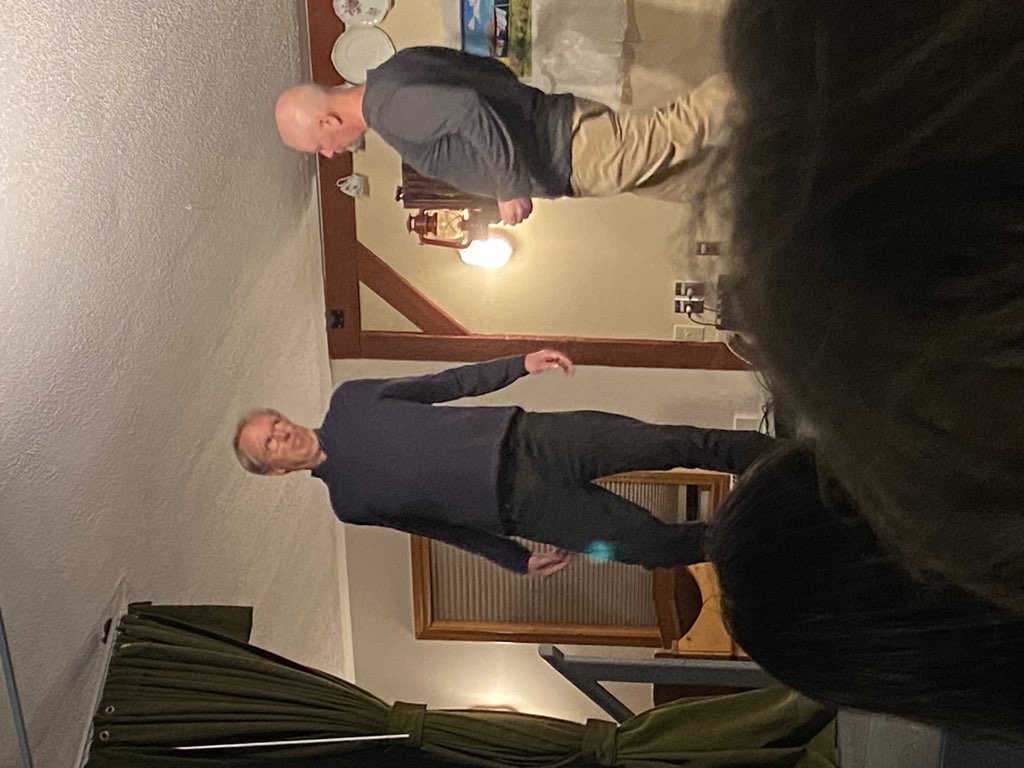
Me and Patrick Trainor walking with our chests way out, part of the introduction to the show. (Photo by Mike Rukavina)
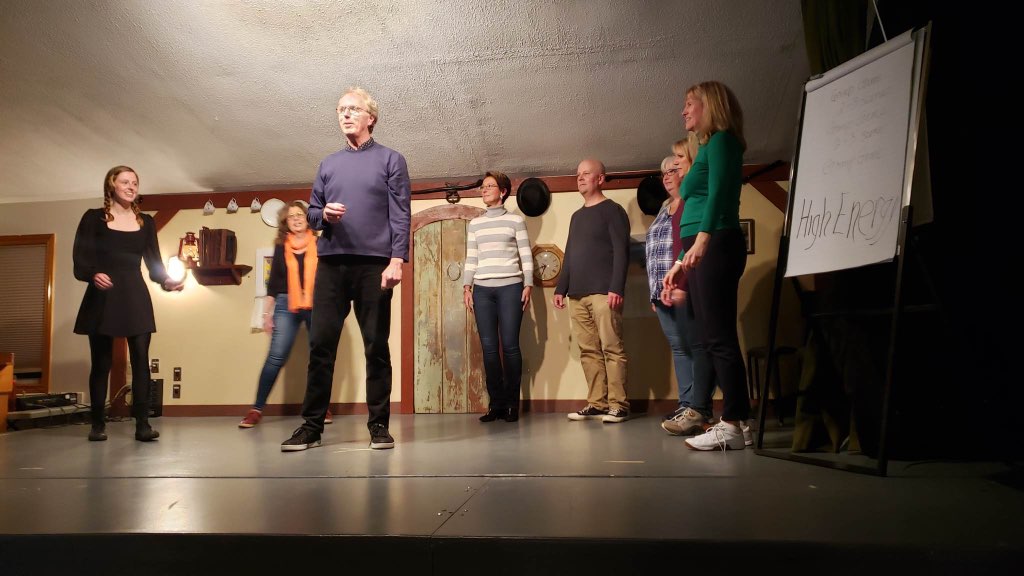
The entire improv troupe on stage: Bridget, Berni, Me, Ann, Patrick, Sue, Pam and June. (Photo by Laurie Murphy)
There are some really interesting things happening in lightbulbs these days, and if you haven’t taken a look at lightbulbs lately, it’s time.
Last month I bought a Merkury Smart Wi-Fi LED Bulb Dimmable White at Walmart for $10 and put it in the front vestibule. Because we already have a Ring doorbell there, and the Alexa app can respond to sensors in the doorbell, I’m able to have the light come on when anyone enters the vestibule, and then off again after 2 minutes of inactivity.
The bulb is also dimmable via apps or voice speakers, so I can “Hey Google, set the vestibule light 30%,” which was nice when we had a vestibule dinner party.
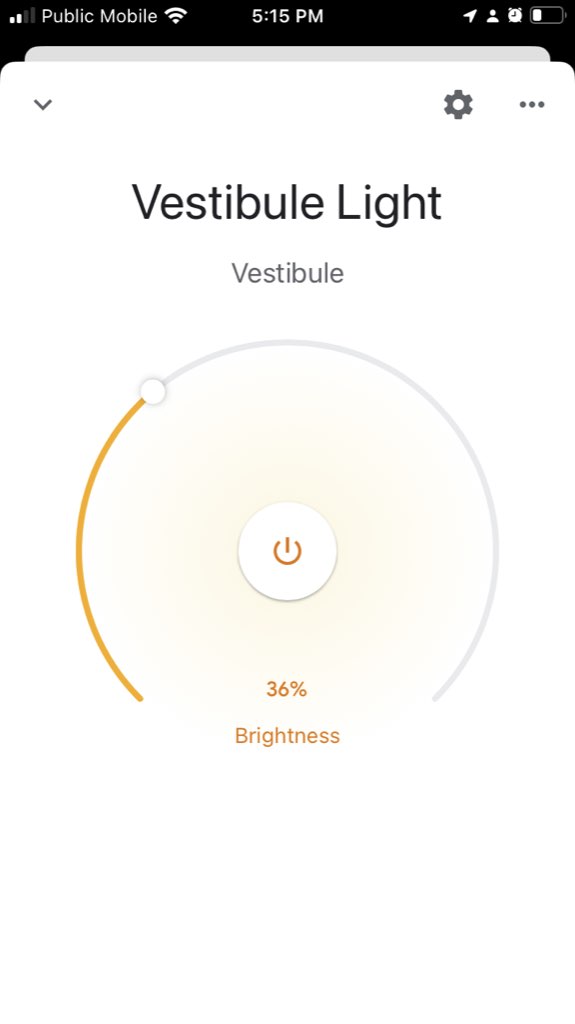
Today at Home Depot I bought a Philips WiZ LED bulb for $20 that has IoT integration, and changes colours on command. So, variously, “Hey Google, change the lamp colour to blue” (…red …green):
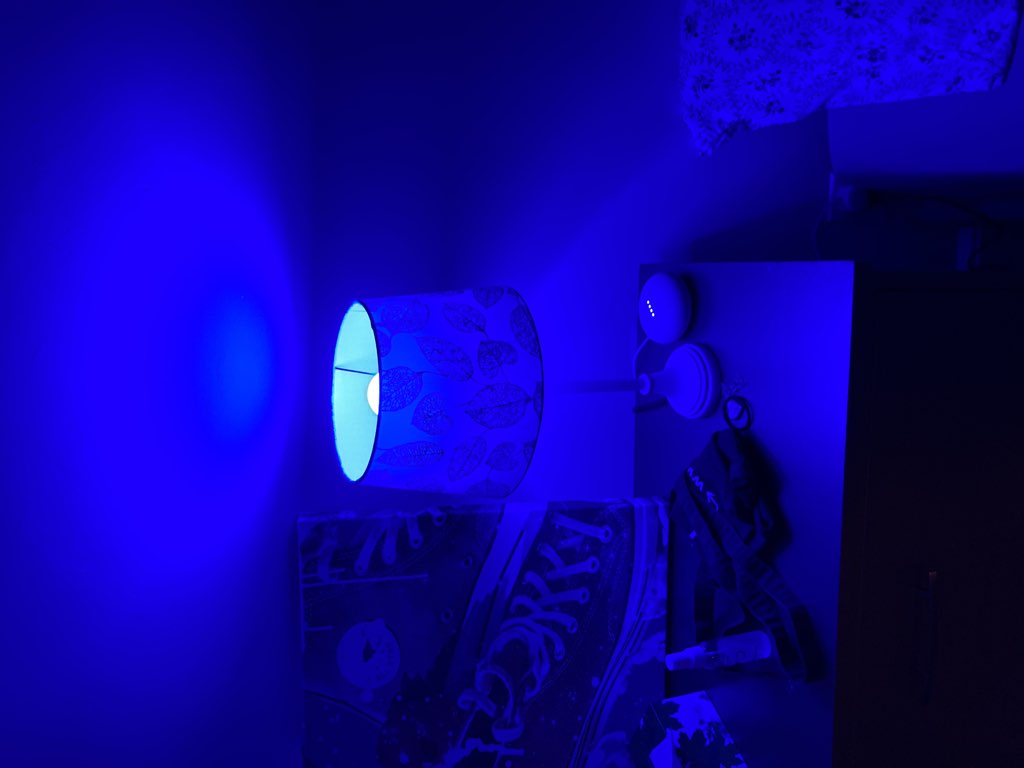 |
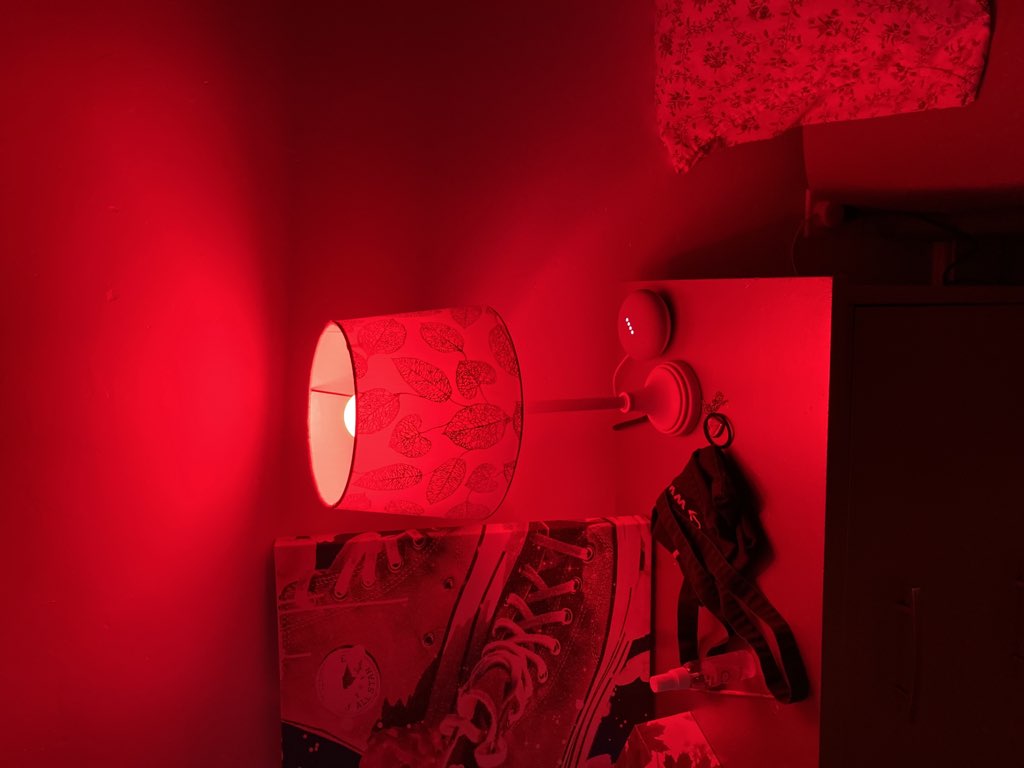 |
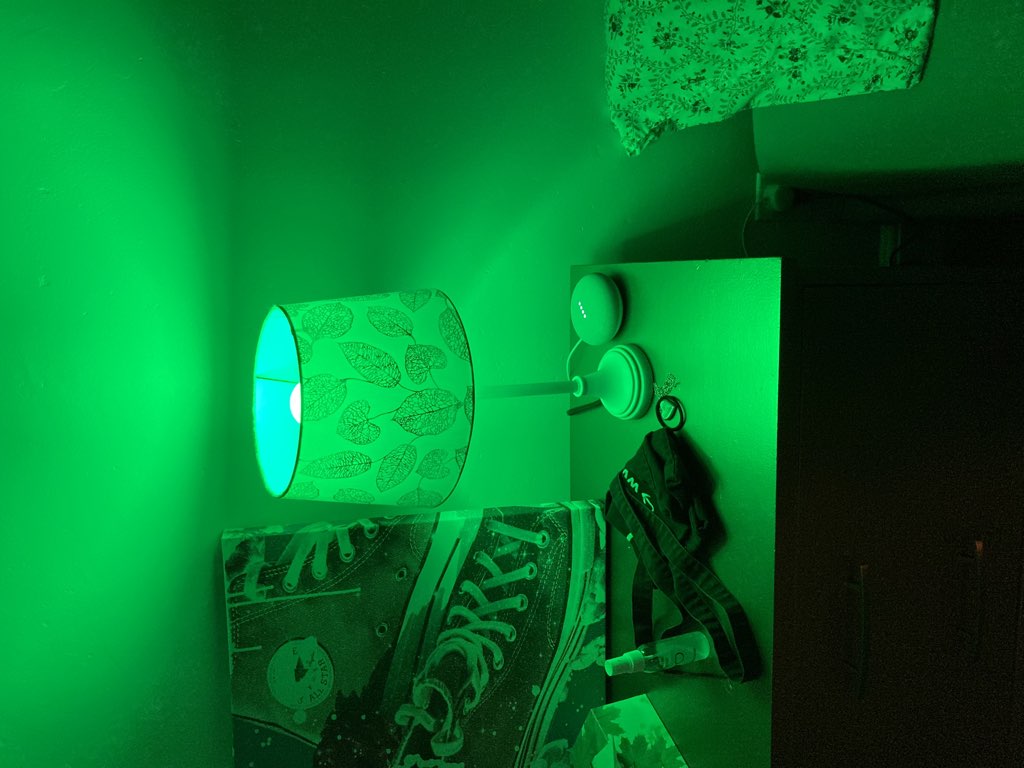 |
What’s technologically interesting about these bulbs is their low price, relative to an earlier generation of IoT bulbs, their ease of setup, and, most of all, how it’s now possible to squeeze enough smarts into the base of a lightbulb for it to be communicated with via Bluetooth and wifi.
The inconvenient thing is that every brand of bulbs comes with its own app that needs installing on my Phone to support setup and integration with speakers and other devices: at present I have—let’s count… Apple Home, Google Nest, Google Home, Wemo, LG ThinQ, genie, Amazon Alexa, Ring, and WiZ—9 apps in total in the “Home” folder on my phone, each controlling a different but overlapping set of devices. Setup of these devices has gotten much much easier with every new generation, but the requirement for each brand to have its own app doesn’t scale much further.
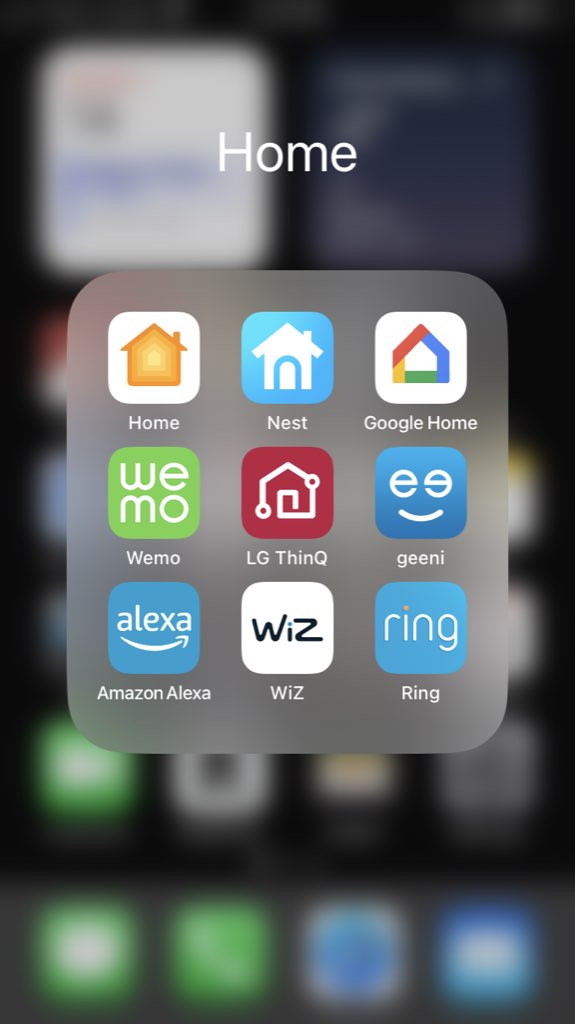
As a result of this foolishness, my home wifi network presently has 30 devices connected to it, ranging from my EV charger to my laptop to my phone to my electricity meter reader.
What a great time to be alive ;-)
Why is it that my Google Home speaker can understand “Meh Groovle” and “Fey Rupal” from 100 feet away, and spring instantly to life, but its reaction to “Hey Google, stop,” when I want it to stop playing something, is to completely ignore me repeatedly.
Ann Cakes hit it out of the park for Olivia’s second birthday party tonight: their tiramisu cake was delicious and expertly-crafted.
 I am
I am